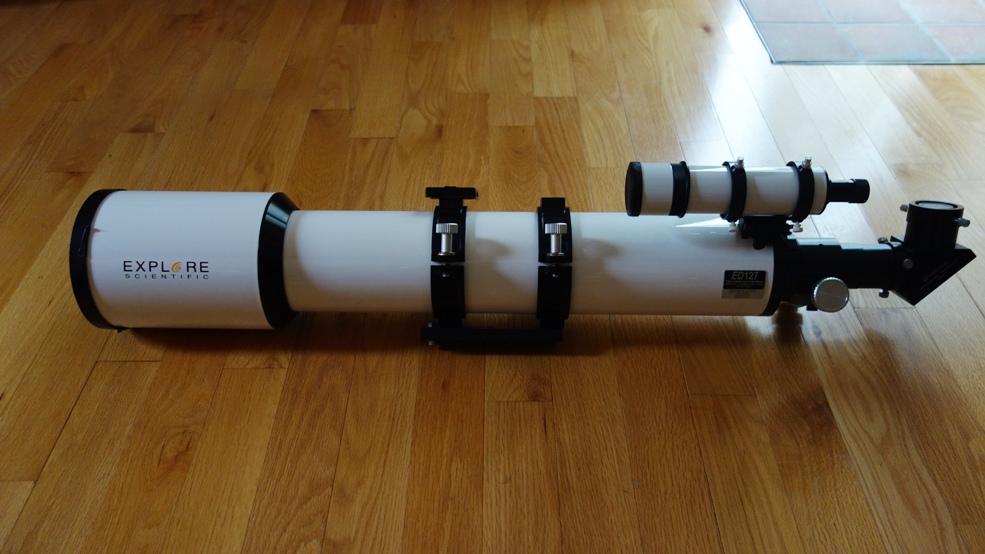
Updated 11/30/16
1) Explore Scientific ED127 OTA 11/20/16
2) Vintage AC Gilbert 80X Reflecting Telescope 11/30/16
(127 mm f/7.5 triplet apochromatic refractor OTA. "Essentials" version includes OTA, rings, plate, finder bracket, $1499, Carbon Fiber unit sells for $1999)
A major bargain. I've seen three of these now, and they're all excellent. For less than $1500, you can have a large aperture apo that competes with the big boys. I think the regular "Essentials" version is just fine, but if the scope's 22 lb weight bothers you, Explore Scientific has a version with a carbon fiber tube that weighs only 18 lbs, and you're still out less than $2000. (When the ED127 first appeared on the market, there was a third version with a removable dew shield and a fitted hard case. The idea of the case is attractive, but the dew shield was the source of ire among owners. In order to fit inside the case, it had to come off and be placed backwards on the OTA. The shield would often scratch the paint on the tube, so ES supplied a piece of curled foam that had to be placed in between the dew shield and the OTA, and even then you had to be careful. I have also been told the older dew shields are heavier, but have not been able to verify this. If you run across one of these versions and are thinking of buying it, be sure that none of this bothers you.) To make matters even more confusing, as of this writing (November 2016) there is yet a fourth version coming out - one with exotic glass for improved performance, and a focuser with a hexagonal instead of circular cross-section for greater rigidity, expected to be priced around $2000.
The quality of construction is good. You are paying for optics, not a work of art (if the latter is important to you, there are plenty of manufacturers out there to accommodate you.) The scope has a generously wide, oversized dew shield, which is becoming something of a trademark with this brand. I like the two speed focuser on the ED127 better than the one on the AR127. It feels more solid and is less prone to slippage. As with the AR127, it comes with the convenient carrying handle (this sample had its handle removed.) Any 5" refractor is bound to be a substantial piece of equipment, but I give credit to ES by keeping its dimensions and weight reasonable. Sitting next to my Takahashi FS102, for example, the ED127 doesn't look that much larger. Only when hefting the tube do you feel something serious is going on. Three pieces of 5" glass are not light, and mounting the scope on my CG-5, I did wind up having to "choke up" on the OTA with the rings (Stupid Human Trick: You can tell an AR127 from an ED127 from a distance by watching where the owner places the rings on the OTA. Close to the lens cell means it's an ED127.) The lens cell can be collimated (although this one didn't need any adjustments.)
The scope will fit on a CG-5 or an AVX class mount with one 11 lb counterweight. Extend the legs and the eyepiece will be at a convenient height for most of your observing. If photography is in your future, however, a CG-5 or AVX isn't going to cut it. These mid-sized mounts are OK for visual use, but the 22 lb OTA weight and long tube length are going to cause you fits. I ran some imaging experiments (see below for results.) When I added my EOS 5D and autoguider, my poor CG-5 saw a load closer to 24 lbs. Although PHD Guiding told me there was very little tracking error during the exposures, many of my subframes showed elongated, comet-shaped, or bouncey looking stars. Most of the 40 second frames on the Orion Nebula looked OK and were usable, but the 3.5 minute frames on the Horsehead were a disaster. Of the ten frames I took, only three were usable, and even one of those was questionable. For photography, you're going to need a CGEM/Altas/G11 class mount, or better.

I have always wanted a Takahashi FS128. They show up used from time to time, and I've come close to pulling the trigger more than once. What stops me every time is the price - even used, they often go for more than $3000. $4K is not unreasonable for a loaded model, and the new TOA130s? Forget about it, too rich for me. If you've ever lusted after a premium 5" apo, I urge you to check out one of these ED127s. I had good things to say about the performance of the achromat version of this scope, but this one is even better. The false color vanishes, and the contrast deepens. The star test on this sample is around the range of the "1/4 wave" illustrations in Suiter's book. If you want to get picky (and apo owners, like Questar owners, are nothing if not picky) you can see a tiny bit of false color on bright stars like Vega at high power, if you know where to look. This only happened at high power, and most of the time I had to defocus the star to see any color to convince myself that I saw it. Again, I only mention this because I know many of you are very picky when it comes to apos.
There's something about a refractor. If you have a 5" apo, people will come over to look at it. If you have a 5" reflector, people will leave you alone. Strange, huh? The best view I've ever had of M8 (the Lagoon Nebula) was through a friend's Takahashi FC-76 with a UHC filter about a dozen years ago. The memory of that view is a big part of the reason I own an FC-76 today.
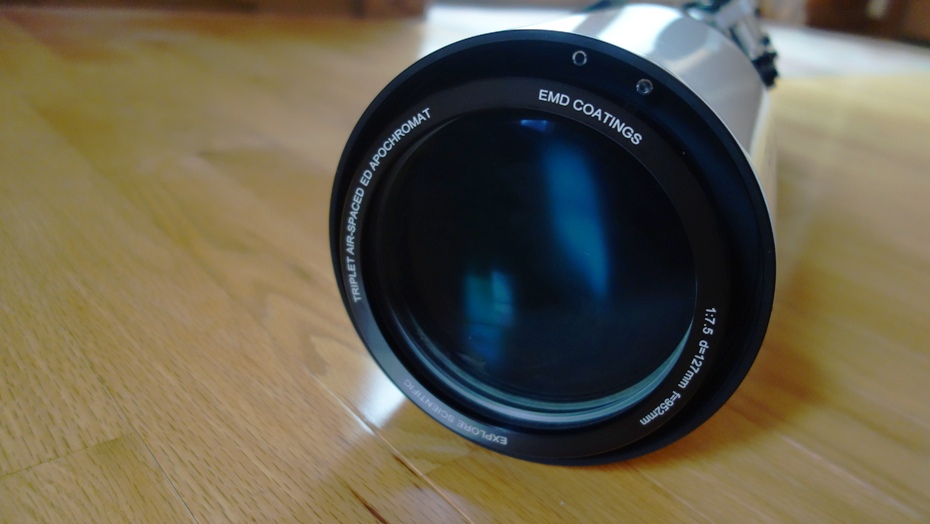
One bugaboo about refractors is that they aren't big enough to gather enough light to be your only scope. If I were starting out in this hobby, would 5" be enough? I wondered about this. I brought out my XT8 and set it next to the ED127. I did this on two different nights and spent about four hours each night going back and forth between them. I took care to try and match powers with similar eyepieces. For example, for low power viewing, a 27 mm Panoptic in the ED127 and a 35 mm Panoptic in the XT8 comes out to 35X in both scopes. A little higher up, 11 mm and 9 mm Naglers come out to roughly 100X. Keep in mind when reading the following that it's an attempt to assess performance, not value. An XT8 is $360, the ED127 is $1499 (and you still have to buy a mount.) But it's interesting to see how this 5" stacks up against an 8".
Back when I was a kid, I sat in my room forming all kinds of opinions about telescopes, mostly by reading manufacturer's brochures. Not that I'd actually looked through anything. Without any experience (or any money; I had to save up $3 just to send away for Celestron's color catalog) it's easy to convince yourself that you know it all. Back then, my younger self would have told you such a test is a waste of time. A 5" competing with an 8"? Gimme a break. On paper, it's like asking a C5 to compete with a C8. Run the test in the real world, however, and things aren't so clear cut. No, I don't expect a C5 to compete with a C8. But a good quality 5" refractor against an 8" Newtonian? I think I need to see that myself. On the Double Cluster, M31, and the Pleaides, I found little to no difference in image brightness between the two scopes. I found the same to be true on the Dumbbell, Ring, and the dim broad cluster NGC 7789 in Cass. Not only that, in every case the refractor was sharper, and had better contrast. On low surface brightness objects like M33, I thought the view through the ED127 was better.
One of my favorite semi-obscure fall objects is NGC7331 in Pegasus. It looks like a miniature M31. If you have a big Dob, this is the galaxy to jump off of when attempting to find Stephan's Quintet. Again, I saw little to no difference in image brightness between the ED127 and the XT8. I liked the view through both scopes, enough that I stopped running tests for a while and just admired the views. Next, I tried M74. This is the object you hate at the start of every spring Messier Marathon. It's like M33, but worse - smaller, dimmer, with even lower surface brightness. Going back and forth between the scopes, it showed up in the ED127 first. It's a little smudge that moves when you tap the tube. Barely there. The ED127 actually taught me to see it in the XT8. On double stars, the ED127 won, as you would expect. I pointed the scopes at low power on Gamma Andromeda, intending to switch out eyepieces for a higher power view. But...even at 35X, the pair was split (with a tiny, tiny bit of black space in between them) in the ED127. Nice! The XT8 couldn't manage this feat; the stars weren't quite tight enough at 35X to see the split and I had to go to higher magnifications to see it. The same held true for Eta Cass. And keep in mind, if you ever get a chance to look through it, my XT8 is good. It is the most used scope in my collection, and it's good enough that I use it as a comparison tool for much more expensive telescopes.
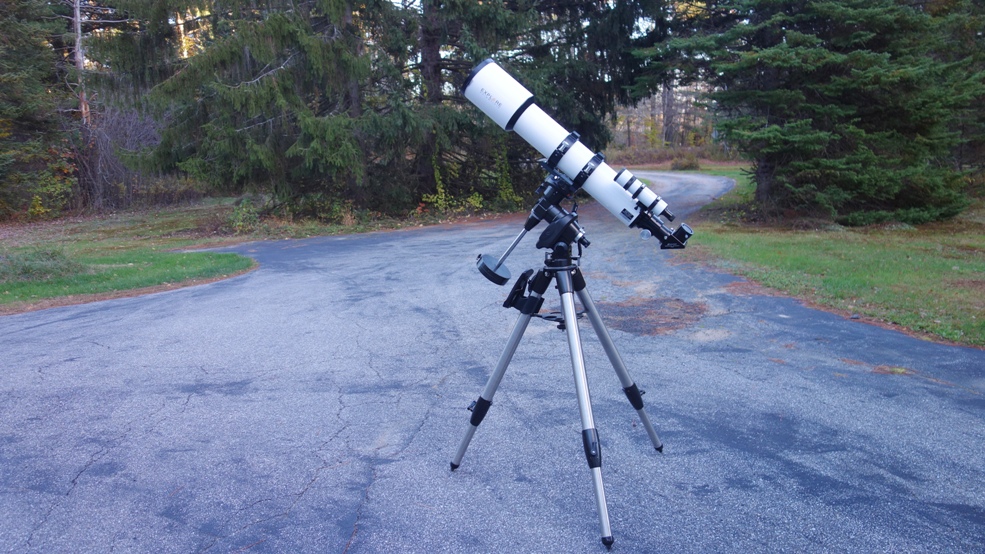
Ummm...you need one of these...
What are you giving up by buying an ED127, as opposed to a Tak, TEC, TeleVue, TMB, an AP, or one the other premium brands? That last little bit of polish, figure smoothness, accuracy in the star test, and color correction. If you are the kind of person who must have the absolute best, who must have perfection, they are out there for you. But I can't think of many telescopes in this range, at this price, that can match this ED127. Note that I haven't done thorough tests on the latest batch of 130 mm-class apos from Astro-Tech, Stellarvue, Orion, Skywatcher, and the others. If I can round up enough samples, perhaps a group comparo is in order.
I am often asked by beginners if they should buy an apo as opposed to an achromat. There is no correct answer to suit everyone. On the surface, the apo is an inefficient use of money. An AR127 is $599; the ED127 is $1499. One cynical definition of an astronomer is someone who's willing to pay thousands of dollars to make a little ring of purple go away. I'm not going to dispute this. $900 is serious money to many people. But as I've seen over and over again, a newcomer to the hobby who buys a quality achromat like the AR127 eventually meets someone with an apochromat, and they see what they've been missing. Over time, our skills and expectations within any endeavor change. They go up or they go down, but they rarely go down. And in time, that little ring of purple starts to mean a lot. Much like the Miata owner who saves up for a WRX or an AMG, we pay for the extra performance, at the same time fully aware of the diminishing returns on our money. Whatever you decide, if you're in the market for a 5" refractor, I can confidently recommend the AR127 and the ED127. I know one club member who owns them both. Such is the nature of passion.
-Ed
ED127 Images
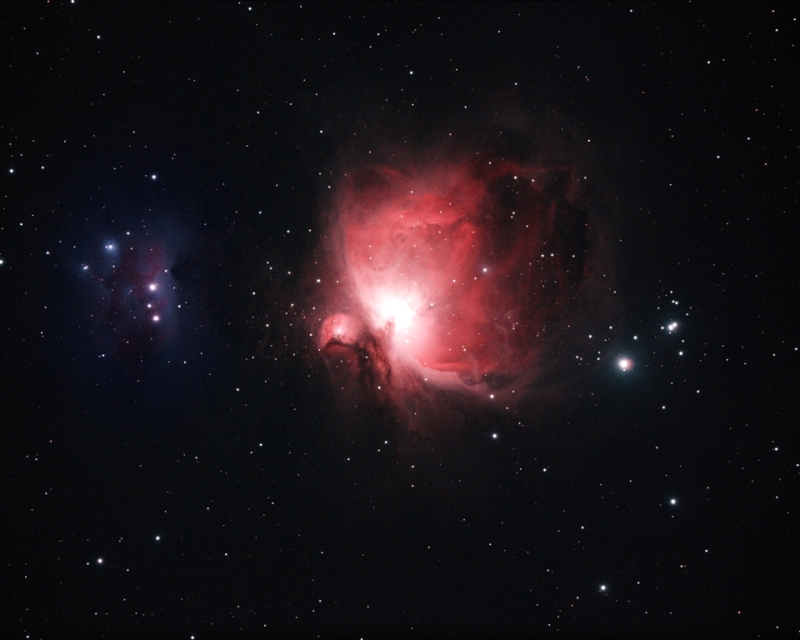
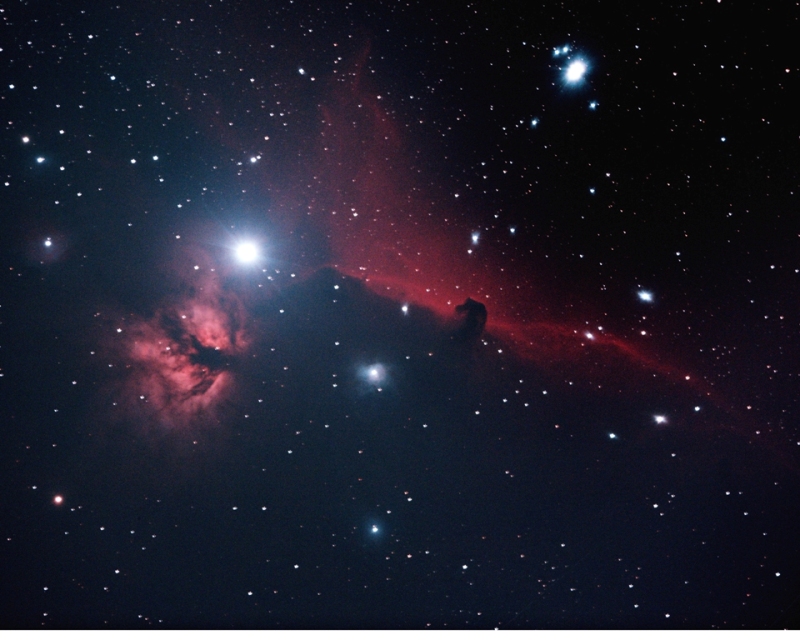
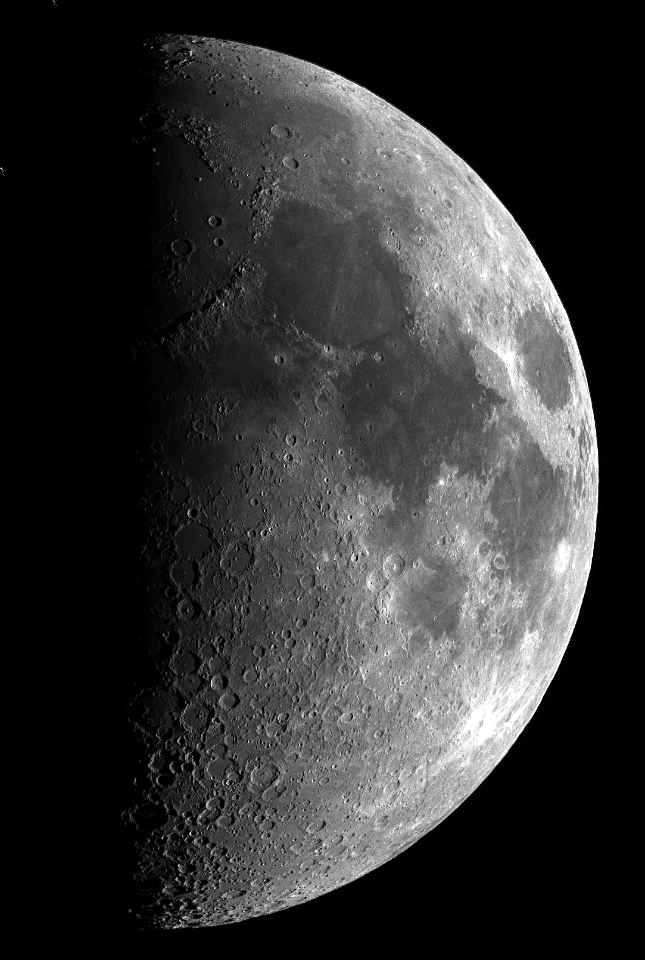
Moon, stitch of 5 images taken with the ASI120MM camera
2) Vintage AC Gilbert 80X Reflecting Telescope 11/30/16
(NLA, 2.5" f/10? Newtonian reflector, fixed 80X eyepiece, metal tripod, sun funnel, zippered carrying case, ~$14.95-$19.95 in 1955-1960.)
The AC Gilbert Company was founded in 1909 by magician Albert Carlton Gilbert in Westville CT. The company is best known for introducing the world to the Erector Set, a toy that remains in production today. The company made chemistry sets, equipment for magic shows, vacuum tube radios, model trains, and other science-related toys. Perhaps most interesting was the "Gilbert U-238 Atomic Energy Lab" which came complete with "low level radiation samples" (!) At its peak, AC Gilbert employed some 5000 people and was the largest company in New Haven, CT. Albert Charles Gilbert passed away in 1961, and after the company sold its shares to the new owners, it struggled to remain profitable, and wound up closing in 1967.
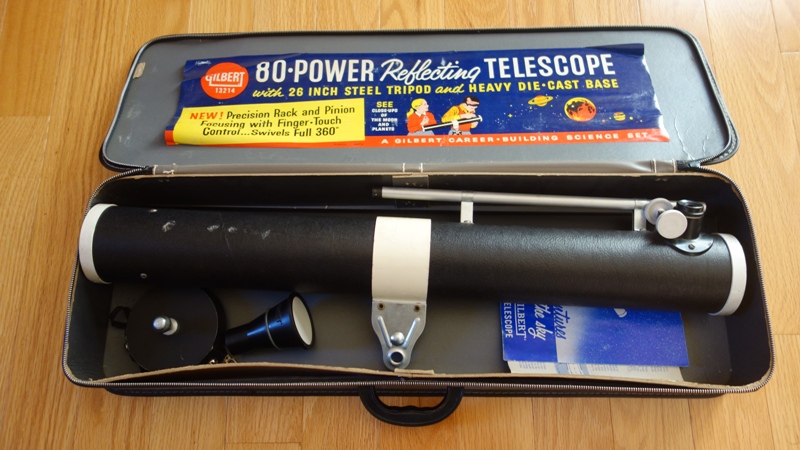
If you can find one in this condition with a bright clean label inside, consider yourself lucky
Although they have not been made or sold in decades, AC Gilbert telescopes show up from time to time in flea markets, on Craigslist, or on ebay. Prices are very reasonable. $10-$15 is not uncommon, and even $5 is not unheard of. As always with equipment of this vintage, the telescopes often arrive with missing or broken parts. However, the patient and motivated collector can cobble together complete units from many different samples over time. Gilbert's advertisements were staples in magazines for decades, and the ads are collectible themselves. Seeing them today takes the reader back to a simpler, bygone era. The boys in the ads always seem to be getting ready to say "Aw, shucks" or "That'd be swell, Dad!" Heck, reading these ads even takes me back, and I wasn't even born then.
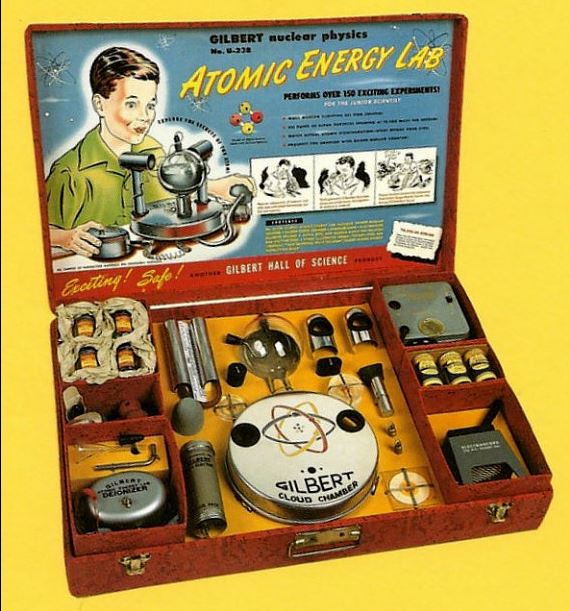
Now, Junior, wash your hands after playing with that Uranium!
Seeing one of these in a club member's house, I asked to check it out. He zipped up the case and handed it to me. My first impression was that the scope seemed a little too light to be taken seriously. Unzip the case and you're greeted by a long black Sonotube OTA with white plastic end rings and a cute little .965" rack and pinion focuser. There are three metal legs and a mounting plate. The whole unit has a simple, utilitarian design that gave me some hope. There are no frills of fancy looking "scientific" extras put in there to impress the owner. This one appears to be a well-preserved sample. The ad inside the lid is clean and bright, and the the zipper is still fully functional. There's a lot of cardboard here. Along with the tube, the case itself is made of thick, pressed cardboard. Gilbert advertised these telescopes as toys, but upon closer inspection, they appear to be a little more than that. The more I handled it, the more I began to suspect that I might be able to actually use the thing. For example, the mirror is held in place by a bona fide, adjustable mirror cell. There's a real rack and pinion focuser, albeit with plastic knobs. A long thin metal tube functions as a sight tube in lieu of a finder. It was only when I inspected the .965" eyepiece that I began to get concerned. It's more or less permanently mounted into the tube. I popped it off, only to find the field lens mounted inside the focuser and a piece of proprietary plastic in my hand. You can't change the eyepiece, although I am told some of these Gilbert telescopes were "40X" models with a different eye lens assembly. 40X seems much more reasonable than 80X.
The (too short) metal tripod legs slot into the round metal base, and the tube ring itself mounts to the base by grabbing the sides of a metal ball with a spring-loaded clip. It's a simple and elegant mechanism, not far from the bowling ball mounts still used by some ATMs. The mount was one of my biggest concerns, but it turns out the motions are more than adequate. In fact, I would say the mirror cell, focuser, and ball joint mount are the three strongest elements of the telescope, and that's already three elements better than some of the junk you see in department stores today.
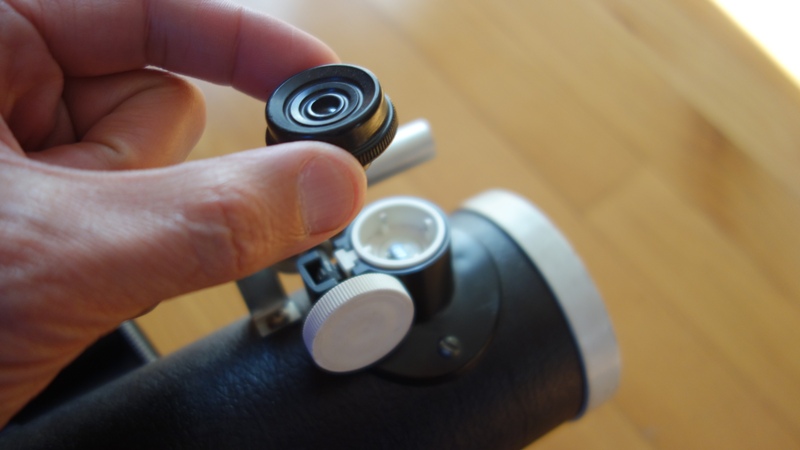
Proprietary .965" eyepiece comes in two parts - the eye lens (in hand) and the field lens (mounted in drawtube.) No substitutions (at least on this model)
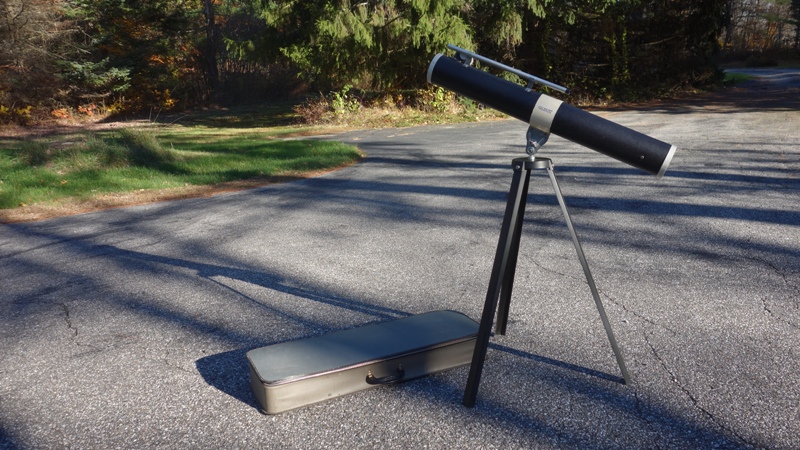
The assembled scope
I tried out the sun funnel. I don't know about you, but I feel nervous pointing any unfiltered telescope at the sun. It took a few minutes, but I did get a white orb to show up in the funnel. What I initially thought were sunspots turned out to be pieces of dust and debris on the optics. Even after a gentle cleaning, the spots persisted.
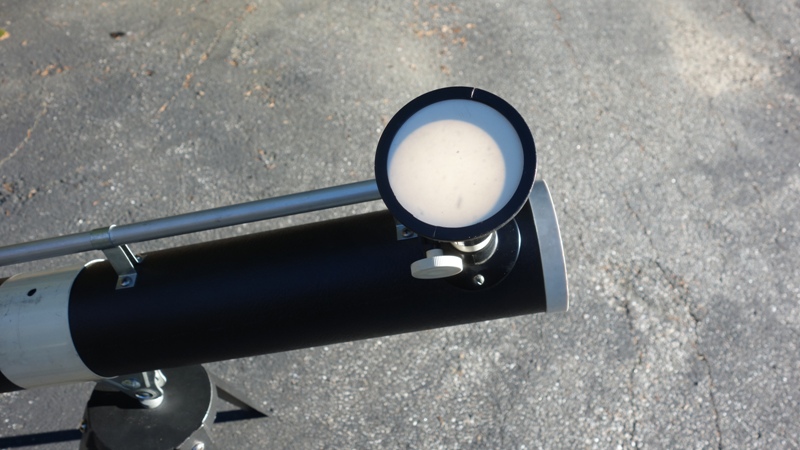
The sun appears in the sun funnel
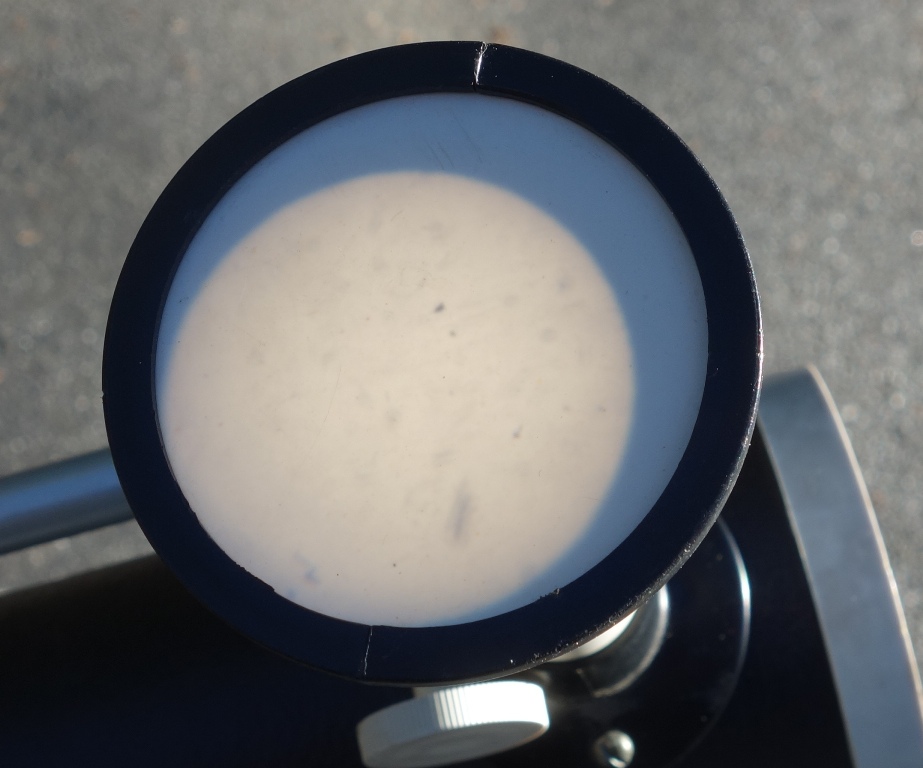
I wish I could tell you those were sunspots, but they're just amplified pieces of dust and debris on the optics
How does the scope perform at night? The moon doesn't look half bad. There's some color fringing on the limb from the cheap eyepiece. There's also limited eye relief, so if you wear glasses, you'll probably have to take them off. We take good scopes for granted these days, but for a kid (or for an adult, for that matter) in the 1950s, seeing the moon through the eyepiece for the first time could be a momentous event. I had no trouble making out Plato, the Alpine Mountain range, and several other features. The thin tube of a finder isn't half bad. I found I could sight Vega and Altair and acquire them in the eyepiece pretty quickly. I ran a quick star test and found the mirror to be modestly undercorrected. Also, after all these years, the mirror seems to have held its collimation. If you point the scope upwards, the little ball joint mounting has trouble holding it in place, no matter how hard you tighten the wing nut holding it there. I had to put my hand underneath the scope to keep it in place. Also, the legs are really short; even a kid is going to wind up crouching on the ground to look through it. After looking at the moon and a few bright stars, things got a lot tougher. I found the Double Cluster, but found it hard to see. I couldn't find the Dumbbell at all, although that was likely due to its position overhead.
And after that? Well...I don't know what observers did back in the 1950s, but I lost interest. I could have gone after M31, but I didn't see the point (M33 was out of the question.) I packed up the scope and up zipped the case. I ran a quick check on the price. $14.95 in 1957 dollars translates into about $128 in 2016. That's not insignificant; an average Joe back in the 1950s would have stop and think it over before buying one of these. This age of $50 Celestron Firstscopes, and $199 Starblasts shows how far we've come. But back then, this was about the only game in town. The 60 mm equatorial Tascos of the day sold for as much as ten times the price of the Gilbert. If you're interested in acquiring a piece of our hobby's history, or looking for a way to recapture lost youth - even if it's a youth you never had - I can't think of a better way to spend a few dollars. Good hunting - I'll see you at the flea markets!